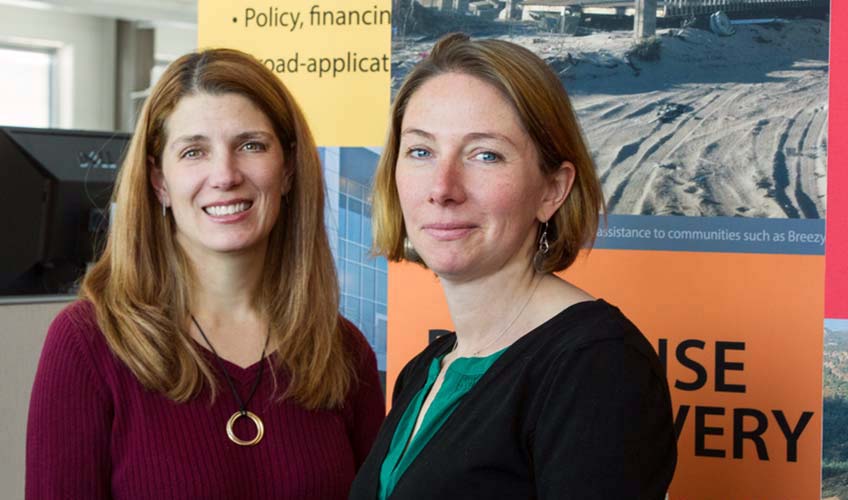Q&A with Eliza Hotchkiss: Refining Resilience in Energy Systems
Eliza Hotchkiss is a new group manager for the National Renewable Energy Laboratory's (NREL's) Energy Security and Resilience (ESR) Center. Hotchkiss joined NREL in 2009 and was recently appointed to develop and manage the center's new Resilient Systems Design and Engineering Group. Her work focuses on developing resilience strategies for community, state, and federal agencies and organizations in response to threats, hazards, and vulnerabilities.

Eliza Hotchkiss (right), NREL Group Manager for Energy Security and Resilience, works to increase deployment of sustainable clean energy technologies and best practices for resilient infrastructure systems. Photo by Dennis Schroeder, NREL.
We sat down with Hotchkiss to find out more about resilience and the opportunities and challenges she is excited to work on. The following has been edited for length.
Talk a little bit about your background and how you came to NREL.
Before NREL, I worked for a consulting firm in England, where I supported the U.K. government with implementing European Union energy policy. I did a lot of carbon footprinting, greenhouse gas accounting, and energy-efficiency analyses. Eventually, it felt like it was time to move back to the United States. In a lot of the research I was doing, NREL kept popping up, so I applied and was hired in 2009. It was exciting to move back to the Mountain West. (Hotchkiss grew up in Wyoming.)
I have been at NREL for more than 10 years in a lot of different roles, but I have been working in resilience for the past 8 years. As a new group manager for ESR, I am excited about this new challenge and where this position could take the center as a whole.
Tell us about your research focus in resilience and clean energy.
I have been involved in disaster recovery work, which has been the genesis of NREL's resilience work. In 2012, after Hurricane Sandy, the Federal Emergency Management Agency asked the Department of Energy to send NREL staff to support hurricane relief efforts, so some colleagues and I applied for what was originally a short-term detail. We were based in New York and New Jersey and spent 6 months supporting recovery efforts on the ground. We identified opportunities to rebuild sustainably using clean energy and energy-efficient strategies. We also developed disaster recovery partnerships with state, regional, and federal agencies to develop resilience plans before and after emergency situations.
In 2014, the White House Council on Environmental Quality asked NREL to lead a 2-year pilot project for the State of Colorado to help design their resilience roadmap. Our team worked with communities throughout the Front Range to develop resilience plans, tools, and long-term energy solutions. We documented the lessons learned during stakeholder engagement and created NREL's Resilience Roadmap, which is intended to be a replicable process for communities, states, and federal agencies to mitigate hazards and risks.
What projects are you excited about?
One exciting project is the Resilience Assessment and Data Explorer (RADE) tool. RADE allows users to enter a zip code to auto-populate local natural hazards and their probability of occurring. We are asked for this type of analysis and data on a regular basis, and RADE could become a really important assessment tool for stakeholders to use to inform their resilience plans. RADE uses data from the National Oceanic and Atmospheric Administration to generate a hazard assessment. The tool is still being refined, yet it can assess the probability of many kinds of natural and human threats, like cyber or physical attacks. The outcome is a risk score for users to assess their vulnerabilities. The next phase in development would include a solutions or risk mitigation module, overlaying renewable energy maps for distributed energy resource solutions. Our geospatial data sciences team at NREL has been stellar to work with during the development of the RADE tool.
I am committed to supporting and continuing to lead the Federal Emergency Management Program's (FEMP) resilience program. That takes a lot of my time, and we have a $1.4 million agreement with FEMP for this fiscal year with a lot of different projects. One project in the FEMP portfolio is developing the Technical Resilience Navigator (TRN) in partnership with the Pacific Northwest National Laboratory. The TRN is a tool for energy and water system resilience planning, specifically for critical loads. It provides guidance for organizations to sustain critical missions during a disruptive event.
Looking forward, what are the biggest challenges you anticipate when it comes to resilience research?
I'm really excited about growing our resilience work and communicating our capabilities externally. I'm working on a couple exciting resilience projects right now at some airports and with the U.S. Forest Service. What I really enjoy about those projects is being a creative problem solver, like an investigative journalist. It's important to ask the right questions to find appropriate solutions. I try not to identify just one solution that is narrowly focused; it's important to think about every consequence in the wake of a disaster—and a variety of solutions for every challenge—to be holistic in resilience planning. Solutions need to be communicated in a way that makes sense to the stakeholders so that solutions can be implemented, which means continuous stakeholder engagement is an essential component of these projects.
What are your interests outside of NREL?
Playing guitar and ukulele, skiing, hiking, canoeing—all the outdoor things that everyone in Colorado does. With a 7-month-old son, it's hard to find time for many activities. Our stroller has skis, so we have been doing some cross-country skiing. We also have a puppy who isn't yet a year old, so there's a lot of new energy at our house, and we try to get outside as much as possible.
Last Updated May 28, 2025
